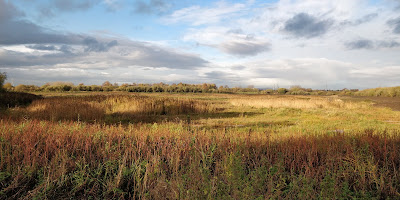 |
| Juvenile scaup, Amberswood Lake |
After an absence of the best part of a month I've seen the first couple of woodpigeons in our bit of Stretford this lunchtime. Evidently I've been wrong in thinking our local population is largely sedentary and augmented by Winter visitors, they must have been among the tens of thousands that steamed through the region this Autumn while the Winter visitors hung back feeling no pressure to move on while the weather was unseasonably mild.
It was a cool, very grey, day and I'd woken up with a mood of not wanting to do much more than potter about. This time of year I like to try and fill in some of the gaps — I've been adding to my list of places to visit quicker than I've been ticking them off — so I got the 132 bus from the Trafford Centre into Hindley and got off at Gregory Street for a walk into Amberswood.
Amberswood's a place I go past quite often without stopping for a look around. I'd noticed the tiny car park and sign by the bus stop and put it on the list to visit sometime. I'll be coming again.
 |
| Amberswood |
The entrance to the park takes you onto a footpath that's part of the cycleway between Hindley and Wigan. (It turns out that the cyclists round here are more considerate and friendly than the churls that power their way through the Mersey Valley.) The first few hundred yards is a corridor bound by high hedges of brambles and gorse bushes with an interesting assortment of deciduous trees behind them. The bushes were busy with a mixed tit flock — a big family of long-tailed tits with great tits and blue tits with chaffinches tagging along — and the trees with a flock of bullfinches, all of which knew to duck behind some twigs whenever the camera got into focus. A coal tit flew along the path, followed by a pair of dunnocks. I was watching the dunnocks fossicking around the base of a gorse bush when a willow tit came over to check me out and let me know it would be happy for me to move along, please.
 |
| Female bullfinch, Amberswood |
Further along the path opened up into young woodland. The birdlife was more thinly spread, and mostly robins, wrens and blackbirds. I turned off the cycleway and dropped off onto the path down to the lake.
 |
| Amberswood |
 |
| Amberswood Lake |
I could hear a class of young kids over on the other side of the reedbeds by the lake. I hoped we'd be going in different directions but we ended up leapfrogging each other round the lake. It wasn't that they were bad, they were excited about being out and about and a lot noisy with it. It's just my hard luck, I'd sooner have them happy and excited about being out in nature than not. I can live with not knowing whether that bird that disappeared into the reeds was a dunnock or a Cetti's warbler.
 |
| Juvenile scaup and black-headed gulls, Amberswood Lake |
A couple of dozen mallards loafed and dabbled on the lake in the company of half a dozen tufted ducks, four young-looking great crested grebes and rather a lot of black-headed gulls, most of which were coming in for a quick bath and a loud squawk before moving on to somewhere or other. Two dark, low-lying shapes turned out to be a couple of immature scaups. They were asleep when I first noticed them but the kids soon woke them up so after a quick wash and brush up they floated off to feed over on the far side of the lake. There were a few coots and a couple of moorhens on the reed margins so it wasn't altogether a surprise to hear a water rail squealing near the path but frustrating that I couldn't see it.
I walked through the park onto Liverpool Road and looked for the bus stop for the 559 to Ashton-in-Makerfield. There was a little car park and some noticeboards next to the bus stop which I assumed were for Amberswood until I took a second look. Low Hall is a local nature reserve that wasn't even on my radar, there was a long wait for the next bus so I had a bit of a wander.
 |
| Low Hall |
Low Hall's yet another of the bits of young woodland that are scattered about Wigan. There were a couple of mute swans and half a dozen black-headed gulls on the pond near the road and plenty of wrens, robins and chaffinches in the limited bit of woodland I explored before I went back for the bus. I suspect a late Summer visit would be good for dragonflies and butterflies.
I gave up waiting for the 559 and walked down into Platt Bridge for the number 9 to Leigh. As we approached Bickershaw I was tempted to nip off for a walk round the old rucks to make up the threesome; limited daylight time, the weather and the timetable for the bus back home persuaded me against it. (To be honest, I didn't need that much persuasion, the knees were feeling the cold damp.) It had been a good few hours' birdwatching and I didn't want to spoil it by being greedy.
 |
| Amberswood |















































